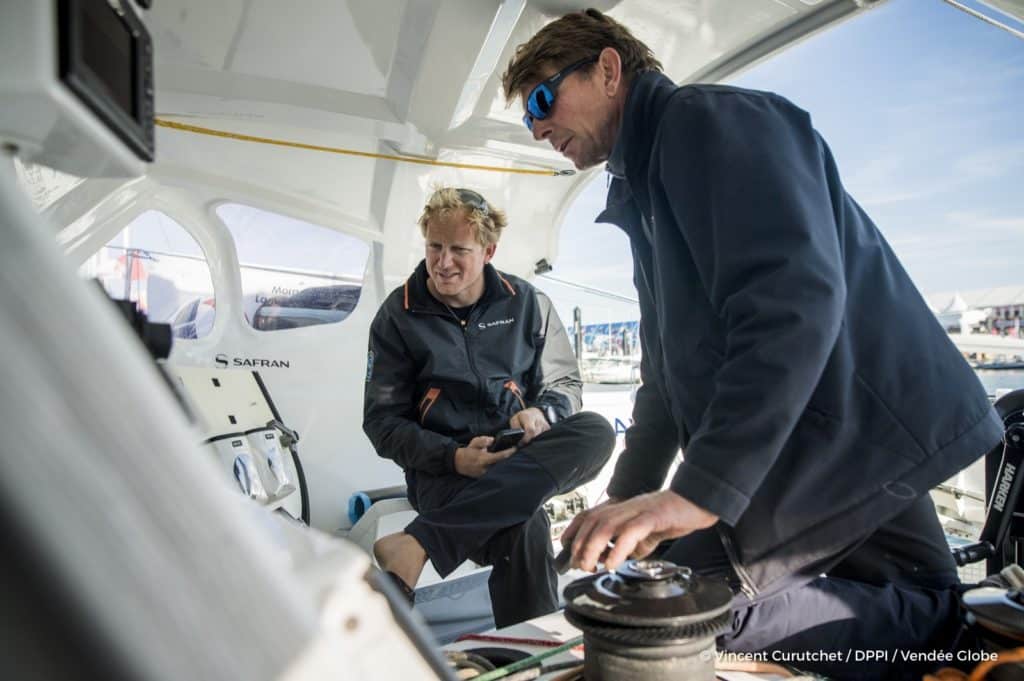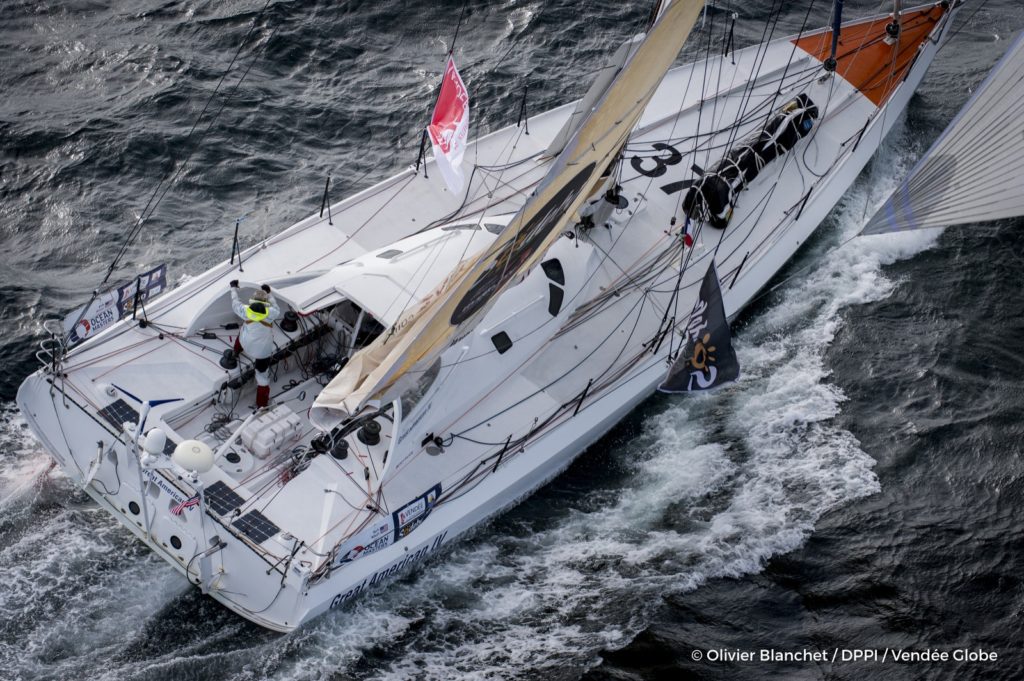
There are resemblances between the Vendée Globe and car racing. There is the technological aspect and then there is the fact that the driver and skipper appear at first glance to be alone. But behind the appearance each of them depend on engineers, mechanics and assistants. Not all of the teams in the Vendée Globe have the same resources. But in many ways that is what is so fascinating about this event. While the top teams, like Banque Populaire or Hugo Boss have a big team with experts working in each particular area, that is certainly not the case for them all.
Safran is one of the bigger teams with their boat fitted with foils. Stan Delbarre, in charge of the technical aspects on Morgan Lagravière’s boat leads a team of five technicians. “Each person has a clearly defined role on board. Hydraulics, rigging, composites and so on. Our team isn’t that big, probably nowhere near the biggest, which means it is relatively easy to manage,” explained the boat captain He is busy checking that the boat is now ready to leave Port-Olona in a week from now. “We know that when we arrive in Les Sables d’Olonne, we are 50% less efficient, so we work hard before that. That is a bigger problem for the smaller teams, who have to borrow gear from the bigger teams. That’s the advantage of being with sailors. I don’t think the F1 teams exchange tyres…” Morgan Lagravière’s boat will be disinfected four days before the start and placed under quarantine. “With 72 hours to go to the start, the boat will be closed. No more visits. We clean her up to ensure that Morgan does not set off with the risk of diseases spread ashore,” explained Stan Delbarre.
The importance of being good all-rounders
On a project like Le Souffle du Nord pour le Projet Imagine, the shore team members need to be all-rounders. Laurent Bourguès is the technical director on Thomas Ruyant’s IMOCA. Having to deal with the mast, sails, rigging and the hydraulics, he has to know his way around in this smaller team. “We are at the lower end of the medium-sized budgets, I think. Everything is ready now and we even have some spare gear,” said Laurent Bourguès. “We’ve been working on this project for 18 months. It’s Thomas, who will set sail, but we are all part of his adventure. We are all sailors and know what can happen at sea. Thomas will be fine.”
Thomas Ruyant’s hsore team are well aware of the extreme difficulty of this solo round the world race, just like the team working on Kilcullen Voyager-Team Ireland, who are Figaro racers, when theya re not dealing with the Irish IMOCA. “What is stressful is wondering whether we have forgotten anything. There si a lot of pressure, because a Vendée Globe often comes to an end because of a few silly mistakes,“ explained Gildas Mahé, Enda O’Coineen’s technician. His colleague Simon Troel added, “It’s fantastic being part of an IMOCA team. There’s nothing more complicated. It is all very high-tech.”
Each man counts
A small budget doesn’t mean that nothing interesting is happening. Far from it. Famille Mary – Etamine du Lys symbolises perfectly the spirit of the Vendée Globe, where adventure meets racing. Romain Attanasio’s project is of a reasonable size. Only three technicians are working on the IMOCA launched in 1998. Philippe Cairo, alias Pipo, was the first to join the project. He tries to ensure that Romain can remain focused on racing. “We work independently, but if Romain wants something, we deal with it. The boat is ready to go. There were just a few final details to sort out in Les Sables.” Rivals during the race, the boat captains and technicians are all one big family and know each other very well. With a week to go to the start, now is not the time for industrial spying. There’s nothing left to hide.

Testing times
Joff Brown is the project manager for Rich Wilson’s Great American 4. The English technician has been involved in one or more IMOCA projects for every start since 2000-1. “They are such complicated boats with so many different parts to them. A boat like Rich’s which is ten years old you are just looking to have changed the things which your experience tells you might fail. In this case it is very much about reliability and getting round. Weight is not so much of an issue. It is about replacing what we can afford to replace. We replaced a lot of electronics, all new B&G and all new wiring, new batteries, new hydrogenerator components. It has a good Southern Spars rig from 2011 with E6 rigging. It has all been inspected and the carbon keel which has all been NDTd.”
“When you test and check things is the key during the lead up period. The thing with a three year project for example is that by the time you are getting to the start period then you are having to replace a lot more things before the race. I have learned so much from recent races. Back in 2000-1 the class was not so developed and we did not really know the lifespan of materials. Even in 2008 for example we were not routinely NDT-ing masts and keels when they were new. When we built Hugo Boss last year then we had an NDT guy in every other week checking everything as it is made. The rig is checked before it even comes into our workshop, the keel is the same. The new boat structures are so light now that it is imperative they are built perfectly and tested all the time.”
Keeping them at sea
Ross Daniel is technical director for Hugo Boss: “Reliability has always been a top priority for us. Sometimes it is hard to see it that way because everyone wants to go lighter and faster, going faster first and then thinking about reliability second. The two go hand in hand for us, more so because of our history over precious years, and now I think we have gone further than the other new boats. The main reason for that is after the boat inverted then we were out of time. The boat was built late, delivered late and we did not do the TJV, we missed the two Transatlantics, we were then back in the shed literally have had to rebuild the boat, that is rebuild it. The boat was under water, submerged, there was no mast, there was a lot of damage to the deck. We new that when we relaunched in April we had just six months to the Vendee Globe. So we had a choice to go back in the water has she was originally which was as you always build a boat, build it then add structure as you go along….as all the new boats have done. Or we could choose to add additional structure and not have to worry about it, then letting Alex get to know the boat, getting the most out of it. So we have added a lot of structure inside and we really have had no problems at all. The hull after doing 12,000 miles is immaculate. I have no concerns at all about that boat going around the world at all.”
“We learned a lot from the last race. We took that boat and added more structure. We had a tried and tested boat, added a little more weight and took a little hit on performance. It was a good choice. I don’t think we have lost any performance at all for having added the extra structure to this boat. We went to New York for the New York- Les Sables and I dont think we lost any performance. I think we were contenders and showed great boat speed at times. We were faster than other boats a lot of the time. So I don’t sit here thinking we added structure and lost anything. I think we have gained a lot.”
If they have technical issues after the start skippers are allowed only to return to Les Sables d’Olonne and restart across the line. The line closes after ten days. But, for example MIke Golding did in 2000-2001 when he lost his mast and restarted eight days and four hours. And in 2008-9 Michel Desjoyeaux has electrical problems, returned and restarted 40 hours after the original start, and went on to win. The Hugo Boss contingency plans are well prepared, ready to swing into action like a well drilled F1 pit crew.
“We have all seen what happens. We were here and saw what Mich Desj did in 2008-2009 and we are set up for any eventuality. We are self sufficient. While Alex has breen training, for example, we are always ready to go anywhere meet him at the dock and get him going again. We have plans for everything. That comes with 12 years experience. And Alex has repair packs for all we can think of. And we have been through lots of different scenarios. If this happens, you do this. One thing we have been good at is keeping Alex at sea. The team we have is very experienced now. We can see from other teams as well. We log all the problems that all of the teams have. Every failure in every IMOCA we know about we have logged. That is an awful lot of work. But we put that into our modelling. That is our intelligence. The Vendèe failures in particular have changed. Before it was keels and masts and that seems better. Rudders, with the kick up systems, are better, there was only one in the last Vendee Globe I think. The aim for the class is to have as many boats get around as possible.” The attrition rate this time? “I don’t think the attrition rate will have changed much. It’s the Vendee Globe.”









